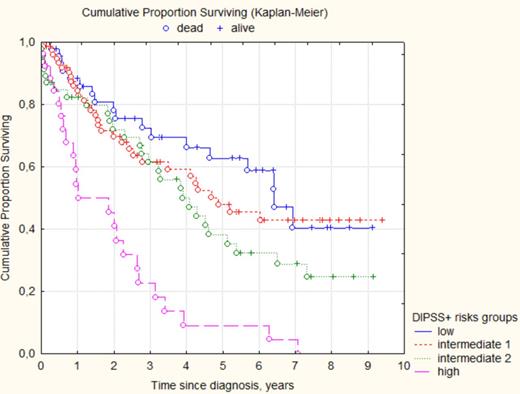Abstract
Objectives and background. Nowadays chronic myeloproliferative neoplasms (MPN) other than chronic myelogenous leukemia undergo renaissance of interest. It results from advances in decryption of molecular mechanisms of pathogenesis and invention of target drugs. Epidemiological information is needed to assess potential effect and additional costs of new diagnostic and therapeutic techniques. The objective of our study was to review experience of MPN diagnostic and treatment in our center for past ten years.
Methods. Our institution serves as primary hematological outpatient department for a half of Saint-Petersburg city with about 2 million inhabitants. We reviewed patients' charts to obtain information about incidence, symptoms, diagnostic test results, treatment options and relationship to prognostic factors. Statistical methods included descriptive statistics, nonparametric ANOVA for frequencies comparisons and Kaplan-Meyer method with log-rank test for survival comparisons in Statistica 7.0 package.
Results. Since 2004 to 2013 there were 570 newly diagnosed MPN patients (pts) in our center. This group consisted of primary myelofibrosis (PMF) (203 pts; 126 female, 77 male; median age 63 years, range 16-83 years), essential thrombocythemia (ET) (201 pts; 146 female, 55 male; median age 58 years, range 23-78 years), polycythemia vera (PV) (166 pts; 96 female, 70 male; median age 57 years, range 20-85 years).
The incidence rates were stable during study period: PMF incidence varied from 0.65 to 1.35 with mean of 1.01 new patient per 100 000 inhabitants per year; ET had incidence from 0.60 to 2.1 with mean of 1.00 and PV had incidence from 0.5 to 1.15 with mean of 0.83. The most prevalent symptoms of disease were: splenomegaly (65.5%), constitutional symptoms (fever, night sweats, weight loss) (31.0%), anemia (36.3%) thrombosis (24.1%) for PMF; fatigue (33.2%), headache and dizziness (25.6%), arthralgia (21.8%), erythromelalgia (15.8%) for ET; plethora (82.5%), headache and dizziness (52.4%), fatigue (31.3%) for PV. JAK2V617F was detected in 49.7% of PMF pts, 57.8% of ET pts and in 97.7% of PV pts. Thrombosis rates according WHO IPSET-thrombosis system risks` groups of ET and PV pts were: low-risk group 3.33% (3/90), intermediate-risk group 11.1% (13/117) and 39.4% (63/160) in high-risk group with highly significant (p<0.0001) differences between risks' groups. There were 169 lethal outcomes in the analysed group (102 PMF; 31 ET; 36 PV). Ten-years overall survival rates were 49.8% in PMF pts, 84.6% in ET pts and 78.3% in PV pts. (fig.1). Overall survival in PMF was significantly influenced by risk stratification as IPSS, DIPSS and DIPSS+. Survival curves according DIPSS+ groups are presented in fig.1.
Conclusions. Patients with MPN are presented in substantial number; therefore need much finance for novel therapy introduction. Risk stratification systems has high predictive value. Innovative drugs treatment results should be evaluated in comparison with historical control.
Overall survival in PMF patients according to DIPPS+ stratification groups.
No relevant conflicts of interest to declare.
Author notes
Asterisk with author names denotes non-ASH members.


This feature is available to Subscribers Only
Sign In or Create an Account Close Modal